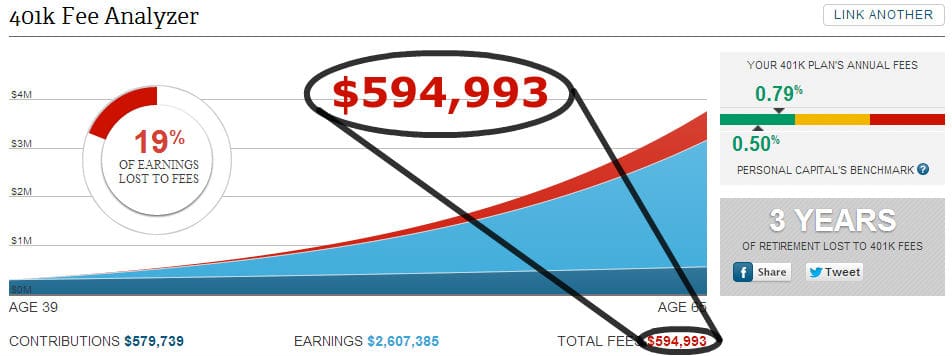

One of the best job benefits available is a sometimes overlooked and little-understood one – an employer-sponsored 401(k) plan. A 401(k) plan allows you to save for retirement on a pre-tax basis and often with matching free money from your employer.
However, what happens when you leave for a new job? Do you move the 401(k) to your new employer, or do you do a 401(k) rollover to an IRA?
There are many things to keep in mind when looking at what to do with an old 401(k). This article will walk you through the pros and cons of what to do with that old 401(k) and how to use it to catapult your retirement savings.
Know the Options With Your Old 401(k)
According to the Department of Labor (DOL), the average person born between 1957-1964 will hold nearly 12 jobs in their lifetime. LinkedIn reports that Millennials will have, on average, four jobs in their first decade after college.
It’s obvious the average person will hold multiple jobs during their career. As you can see, if each of those jobs came with an employer-sponsored 401(k), those plans would add up quickly, making it vital to know what to do with those old 401(k) plans.
Here are four key options to know when looking at an old 401(k) plan:
- Stay put. In some cases, it’s an option to leave your 401(k) with a former employer. If you know the plan and like the funds in it, this could be a desirable option. There are a few things to keep in mind though. First, if your balance is under $1,000 the employer has the right to cash out your plan. However, if your balance is over $1,000 the 401(k) rollover rules offer you the ability to rollover the 401(k) to an IRA if you wish. Additionally, you may be charged higher fees or not have access to the same funds if you’re no longer an active employee.
- Move it to your new employer. Rolling your old 401(k) to your new employer is an option many investors take. The main benefit to rolling over an old 401(k) to your new employer is that you get to keep one single plan. For those wanting simplicity with their investing this may be an ideal option.
- Rolling a 401(k) into an IRA. Rolling over your 401(k) into a Rollover IRA is, for many, the best option to take with an old 401(k) plan. In this instance you transfer the funds to a Rollover IRA with an online broker. This provides many benefits, from exponentially increasing your investment options to the potential for considerably lower fees – both of which can have a direct impact on your retirement portfolio.
- Cash it out. In many cases this is the last option you want to consider as you lose out on growth opportunities, not to mention the tax implications. The IRS requires at least a 20 percent penalty on early withdrawals, and you may be liable for more taxes and fees so in many cases it shouldn’t be an option you should pursue.
As you can see out of the four options, the middle two really stand out. Assuming you want to pursue one of those options, here’s how to rollover a 401(k).
The Main Reason Why You Want to Consider Rolling Over Your 401(k)
You may be tempted to rollover your 401(k) to your new employer or simply leave it with your old employer.
That may be fine in some cases but in most cases the fees you open yourself up to don’t make sense, especially if you work(ed) for a small business. The average 401(k) fee is 2.22 percent for businesses with less than $2 million in assets under management and 1.29 percent for all businesses. The fees may seem insignificant – they’re not.
Consider numbers shared by the Center for American Progress. They state a one percent difference in fees charged to someone just starting to save for retirement at the median salary of just over $30,000 adds up to more than $100,000 over the course of 40 years.
The numbers are worse for high-income workers earning at least $75,000 starting at age 25; in that case, the loss due to fees totals over $300,000. When you look at the myriad of fees charged in many 401(k) plans it just doesn’t make financial sense in most cases to stand pat.
An IRA, on the other hand, opens up numerous fee savings opportunities, especially when you open an IRA with Vanguard or low-cost robo-advisors like Betterment or Wealthfront. Such brokers offer access to low-fee funds that make more of your money work for you and not line someone else’s pockets.
If you don’t believe me, just use the free fee analyzer at Personal Capital to compare the fees charged by the funds in your old 401(k) versus what you’d pay at a low-cost brokerage or robo-advisor.
The numbers will generally tell the same story – you’re leaving a ton of money on the table.
Just How Much Can Fees Affect Your Retirement Fund?
Because of the power of compound interest, even a tiny difference in fees can have a massive impact on your retirement portfolio.
When InvestmentZen contributor Mr. 1500 ran Personal Capital’s fee analysis tool on his 401k portfolio, he discovered that with his current portfolio, he was going to pay a whopping $594,993 in fees over the next 26 years:
After he discovered this terrifying fact, he spent just a few hours moving his investments around and reduced his potential fees to just $86,163, saving him over $500,000 dollars for retirement.
If you want to have more money available for retirement, signing up for a FREE account at Personal Capital to take advantage of their 401k analyzer is an easy way to do it.
It might just save you $500,000 dollars (or more).
How to Rollover 401(k) to IRA
Now that we know it often makes sense to do a 401(k) rollover, it’s important to know how to roll a 401(k) into an IRA.
There are several IRA rollover rules to keep in mind to ensure it’s done right, and avoid getting hit with a nasty fee or tax hit. Here’s what to know:
- Open an appropriate IRA with an online broker or robo-advisor. In many cases, this will be a Rollover IRA – which acts much like a Traditional IRA. You may want to convert a 401(k) to a Roth IRA. This will include several extra steps and tax implications, but it is possible.
- You contact the administrator of the old 401(k) plan and inform them you plan to do a 401(k) rollover to an IRA. They will likely have a form for you to complete to initiate the process.
- Wait for the money to transfer to your IRA or new 401(k) plan. Ideally, you will have the funds sent directly to the brokerage or new administrator. This helps avoid any taxable consequence. If the funds are made payable to you, the IRS allows a 60-day window to get the funds into the new account, but different tax issues may arise.
- Invest your money into the funds of your choice. Remember to use the free fee analyzer at Personal Capital to analyze the funds you choose.
In many cases, the broker you choose to open an account with will have specialists to walk you through the entire process to make sure it’s done right. Thankfully it’s a fairly straightforward process, but you want to make sure it’s still done correctly.
Should I Rollover My 401(k) to an IRA?
Deciding whether or not to rollover your 401(k) into an IRA is a serious decision.
You need to consider many factors, but it comes down to how you envision your retirement. Your 401(k) plays a key part in what kind of retirement you enjoy and it requires active participation on your part.
Let’s take investment fees as one reason why you should consider a 401(k) rollover to an IRA. The average 401(k) plan charges north of one percent in fees.
Again, those seem small but over the course of a career that can significantly shortchange where you could be thanks to losing out on compound interest. Opening an IRA with Vanguard or a low-cost robo-advisor like Betterment or Wealthfront, on the other hand, helps you slash your fees and keep more of your money working for your retirement.
Lower fees are only one part of the two-pronged benefit of rolling over a 401(k) into an IRA. The other prong is countless investment options versus a small handful of funds typically found in most 401(k) plans. Together, those two prongs can put you on much better footing for obtaining the retirement you want.
The Ultimate Goal
In the discussion of rolling a 401(k) to an IRA there is one key point to keep in mind – you want to do all you can to maximize your retirement planning efforts. That includes finding ways to cut the fees you’re paying to invest and increasing the number of investment options you have.
When put together they can greatly increase the amount of money you will have for retirement when the time comes – whether that is decades from now or an early retirement.
Making the decision of whether or not to do a 401(k) rollover to an IRA can seem difficult, but it really isn’t.
There are tools available, like Personal Capital, to identify money saving opportunities, as well as low-cost brokers like Vanguard or Betterment that help you track with the market instead of trying to beat the market. If you have any old 401(k) plans with former employers, it pays to consider rolling them into an IRA and put your retirement planning on the right track.























